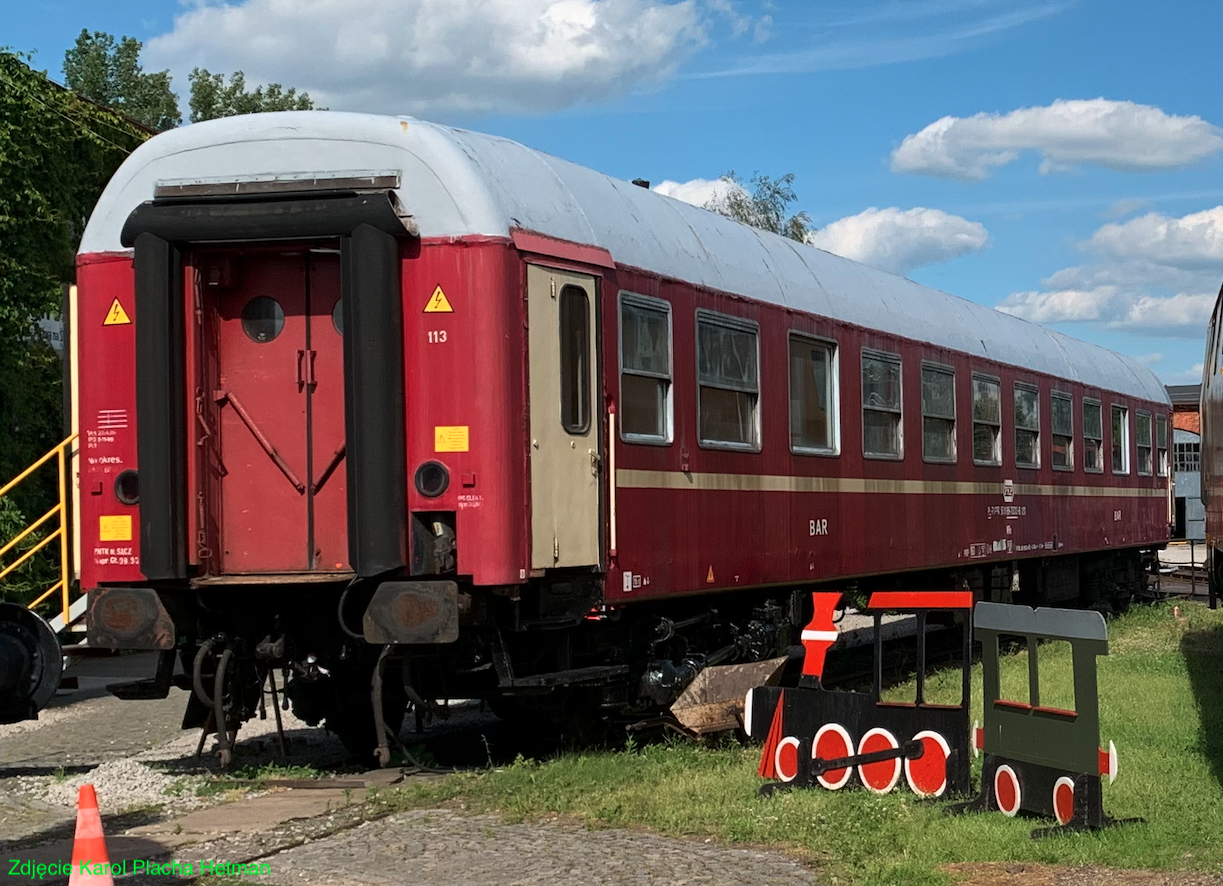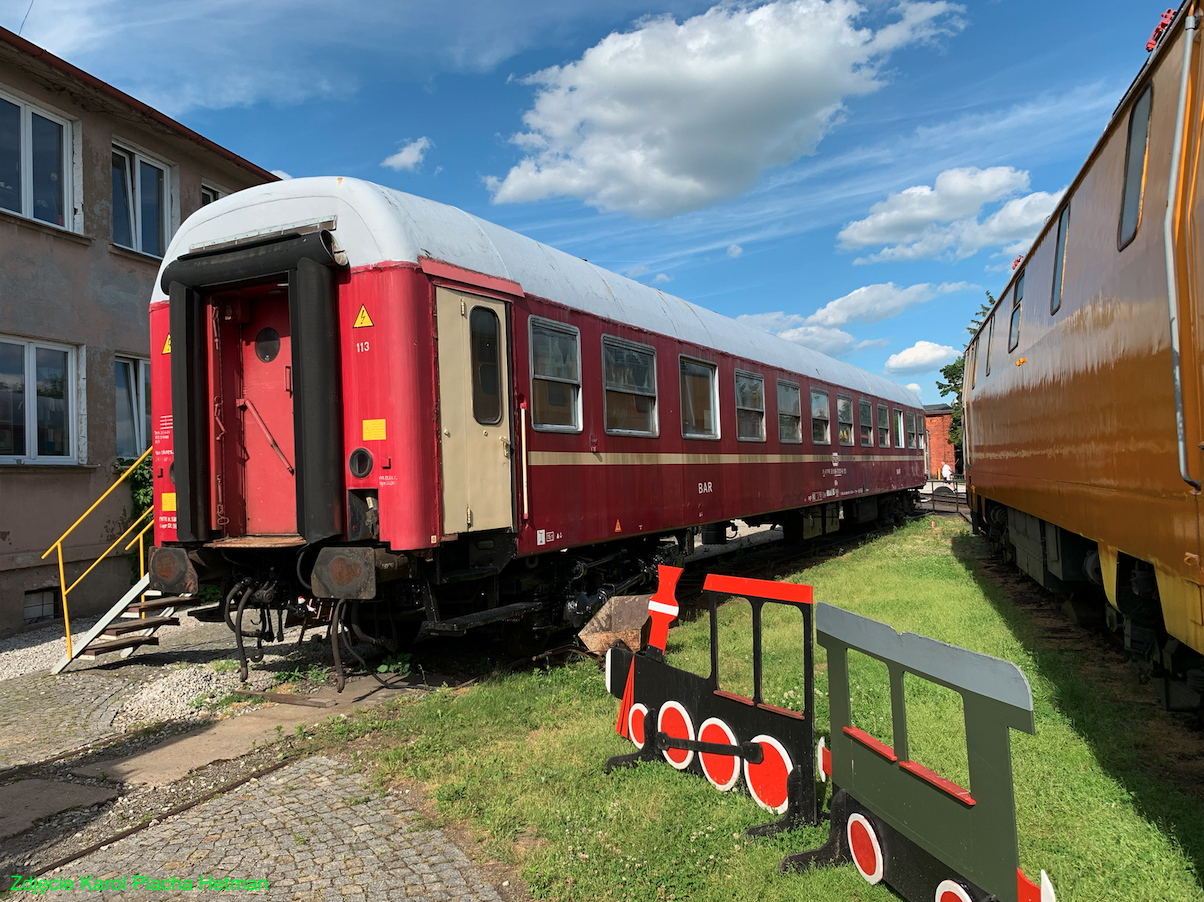Jaworzyna Śląska 2023-08-14
Passenger and bar cars type 113A. 1972.
The wagon type 113A, "Y" standard, is a passenger car with a bar compartment. It was the first catering car of Polish production after the Second World War. The wagon was commonly associated with the WARS company. The type 113A car was based on the type 104A, Class 2, with 10 compartments and 80 seats.


The history of WARS.
After the Great World War, in Poland, the Enterprise of Sleeping and Restaurant Wagons was established, for which wagons were produced in factories in Poland. Unfortunately, the stupid Germans, together with the Muscovites, started the Second World War and suffered further territorial, property and image losses.
In 1948, in socialist Poland, a state-owned company for the operation of sleeping and dining cars was established as part of the ORBIS Travel Agency. In 1953, the company was transformed into the Enterprise of Sleeping and Restaurant Cars ORBIS. In 1960, the name was changed to the Enterprise of Sleeping and Restaurant Wagons WARS. The WARS company dealt with gastronomy and sleeping cars as part of the PKP; on trains and at railway stations.
In the 1970s, WARS ran gastronomic establishments at railway and bus stations and at the Okęcie Airport and at the Gdańsk-Wrzeszcz Airport. These were Category I and II restaurants, buffets, bars, cafes, kiosks on the platforms. WARS employees also carried out door-to-door sales on trains while they were parked at railway stations. In Silesia there was also service on trains between major stations.
Until 1989, wagons operated by WARS were maintained in technical condition by PKP. They were painted green (dark olive). On the sides there was a white inscription WARS written in cursive. In the 1990s, wagons leased by WARS from PKP were painted in the following colors: catering - brown (rust color), couchettes - blue, sleeping - navy blue.
In the 1990s, WARS was transformed into a joint-stock company with 100% share of the State Treasury. In 2005, 50.02% was taken over by PKP InterCity, and the State Treasury continued to hold the rest.
In 2012, WARS served 15 restaurant and 46 bar cars, 79 sleeping cars and 55 couchette cars. These wagons could be found on 44 PKP InterCity railway routes.
Currently (2023), the WARS company employs 1,400 employees, provides catering on InterCity trains, provides services for foreign carriers, operates restaurant, bar, sleeping cars and couchettes. He owns four restaurants in Warsaw. The main branches of the company are located in Warsaw, Krakow, Szczecin and Gdynia. The company also provides cleaning and washing services for passenger cars. Currently (2023), the wagons have new colors, adapted to the standards of the owner, i.e. PKP InterCity. They are distinguished by the appropriate color of the belt above the windows.
Type 113A wagon.
The "Y" type 113A car is a passenger car with a bar compartment. It was the first catering car of Polish production after the Second World War. The wagon was commonly associated with the WARS company. The type 113A car was based on the type 104A, Class 2, with 10 compartments and 80 seats. The wagon prototype was built in 1972 at HCP in Poznań. The car had 4 passenger compartments, each for 8 passengers. The rest of the car was designed as a bar. You could buy at the bar; tea, coffee, mineral water, cigarettes, newspapers and, above all, hot meals; bigos, baked beans and tripe. Standard vestibules with pivot doors, passages to the next car and toilets have been left in the cars.
Serial production of type 113A wagons was carried out in the period 1974-1976 and after a certain break in the period 1976-1977. A total of 230 113A type wagons were built. Over time, many carriages were modernized and converted into completely bar, bar-restaurant or restaurant carriages. Most of the modernization was done after 1989, until 1999. Conversions of wagons were carried out in Nowy Sącz, Opole and Bydgoszcz. Some wagons were replaced with bogies of the 25AN type, which allowed for a maximum running speed of up to 200 km/h.
The 113A type wagons were also used by PolRegio, until the carrier resigned from long-distance connections, which finally took place in 2015. The carrier had 10 wagons.
In 2009, 140 type 113A wagons were still in service. Most of these wagons had already been reconstructed.
Wagons type 113Aa.
Type 113 Aa cars are modernized type 113A cars for the InterCity carrier. But there are also 113Aa type wagons for Przewozy Regionalne, which were built from 112A type wagons. They are a car with a passenger part, without compartments (30 armchairs with a corridor in the middle) and with a bar part (buffet and 4 tables). The front door is dodge-sliding. Pasted windows. Closed toilets. There is a railway information system in the car. 230 V sockets and Wi-Fi system. There is air conditioning in the carriage. The bogies of the 113Aa type were also changed from 4ANc to the 4ANcS version. The cars were made from the conversion of type 112A cars, not from type 113A. They were built for Przewozy Regionalne. The 113Aa PR and 113Aa InterCity cars differ both externally and internally.
T-T data of the wagon type 113A:
Total length 24.50 m. Width 2.88 m. Height 4.05 m. Service weight 33,500 kg. Top speed 160 km/h.
Written by Karol Placha Hetman
